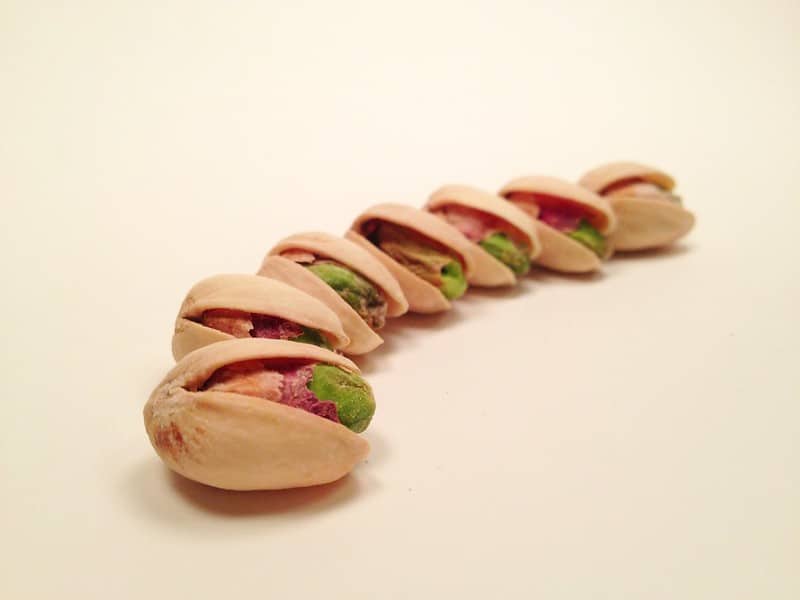Pistachio nuts make a great snack because they are nutritious and taste really good. You can have them in ice creams, baked delicacies, candies, pudding, or even in dressings.
However, pistachios can be quite expensive, especially when compared to other nuts. Why is that?
Pistachios are primarily expensive because of high production costs. The pistachio trees take years to mature and more than a decade to produce a significant harvest. The process of harvesting and preparation is also tedious, labor-intensive, and time-consuming. All these factors contribute to the final high price of pistachio nuts.
Now, let’s dive into the world of pistachios and learn more about these globally loved exotic nuts.
How Do Pistachios Grow?
Pistachios are native to Central Asia because they do well in arid and semi-arid climates that experience long and dry summers.
The trees take between seven to eight years to start producing any harvest but full maturity for good production can take up to 20 years.
Pistachio trees need both male and female trees to pollinate. Farmers grow male pistachio trees upwind about 10 to 15 miles from the female trees. One male tree can pollinate up to twelve seed-bearing female trees.
The pistachios grow in grape-like clusters with each cluster bearing about thirty to fifty nuts. One tree can produce on average, about 50 pounds of pistachios.
The trees are biennial bearing, meaning that they produce heavily one year, lightly the next, and so on. Harvesting is done using heavy machinery and the nuts are taken for processing.
Pistachios are susceptible to quite a number of diseases and infections. In the past, a decline in production due to diseases have caused global shortages.
Where Do Pistachios Come From?
Turkey and USA are the major global producers of pistachios. According to the UN Food and Agriculture Organisation, the two countries accounted for 68% of the global production of pistachios worldwide.
Iran, China, and Syria follow closely in production numbers. Iran was a major producer of pistachio nuts for a long time.
However, the country was knocked off the top global producers’ list following US sanctions, poor water management, and other factors.
Average Shelled Vs Unshelled Pistachios Prices
Pistachios come shelled or unshelled. In-shell pistachios are sold with the hard coat still on and are green on the inside.
Shelled pistachios have the shell already removed. Here is how the prices of the two compare;
- Shelled Pistachios Price
Roasted unshelled pistachios cost $19.9 for a 1lb bag.
- In-Shell Pistachios Price
In-shell pistachios cost $12.99 for a 1lb bag
Why Do Pistachios Cost More than other Nuts?
1. Processing Costs
From the moment that pistachios are planted, they require hands-on management. This is especially true during processing.
Once harvested, pistachios must be hulled and dried within 24 hours. They cannot be stored unprocessed like other nuts such as walnuts.
The machinery used is specially made for this one process and costs a hefty sum. This in turn makes these nuts quite expensive to the consumer.
2. Long Growing Time
Pistachios take longer than 15 years to mature into reliable crop-yielding trees. This means that it also takes longer to see any return on investment, especially for new farmers.
3. Sensitive to Climate
Pistachio trees only grow in select climate regions. Considering that they require large acreage to make any sense as a commercial venture, this means that there are certain restrictions geographically.
Additionally, any unforeseen changes to weather are fatal to the harvest.
4. Susceptible to Diseases
Pistachios are very sensitive to diseases and insects. One example of the top damaging fungi to pistachios is the fungus Botryosphaeria.
This fungus causes shoot blight and death of the trees’ flowers and young shoots. It has been known to wipe out entire pistachio orchards.
Having these scenarios as a constant threat means that the risk is passed on to the consumer through higher prices.
5. Harvesting Costs
Unlike other nuts such as almonds that are shaken from the tree and collected, pistachios demand a more intense process during harvesting.
These nuts have to be harvested fresh with heavy machinery that is very expensive. Furthermore, the pistachios have to be processed quickly to ensure freshness. This constraint on time makes the whole process quite draining financially.
Most Expensive Pistachios in the World
The most expensive pistachios in the world are produced in Sicily, Italy. These pistachios are so valuable that they require annual police protection to ensure that no harm comes to the trees.
The variety grown on the Italian island is officially named Bronte, also referred to as “Sicily’s green gold”. It is said that the variety was introduced to Sicily during the Arab occupation of the island.
The environment is not very favorable to farming but the Bronte pistachios have thrived in this area. The growing area in Bronte has thin soil.
The surrounding area is also rocky and sloppy and barely supports any other plants. Due to the topography, all the nuts have to be hand-picked in a labor-intensive and time-consuming process.
The Bronte pistachios account for only 1% of the total global production of pistachios but sell for the highest prices.
This variety costs as much as $17.40 per 2lbs. That’s almost double what the other 99% of the world’s pistachios costs. Major markets for this variety include German, France, and the US.
What is a Good Price for Pistachios?
On average, shell-on pistachios cost 75 cents per ounce in major supermarkets. The shell-off kind is more expensive, retailing at around $1.50 per ounce
Read Also: Why are Macarons So Expensive in the US?
Where to Buy Pistachios
Despite the relatively high price, pistachios are readily available at local stores.
If buying online, Amazon stocks the flavourful brand, Wonderful Pistachios.
They have a vast collection of both shelled and unshelled pistachios. The sealable bags come with roasted, salted, and even honey slated options.
If looking for a snack to fit your bag on the go, there are different sizes to choose from as well.

